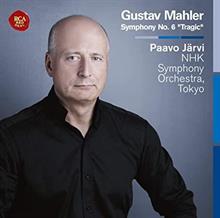
Controversy has surrounded Gustav Mahler's Symphony No. 6 in A minor, "Tragic," ever since he reversed the order of the inner movements, from what he originally published as Scherzo/Andante, to Andante/Scherzo, which became his actual practice. Whether one favors the former or the latter ordering may be a moot point, with a century of recordings of both versions indicating the general acceptance by audiences in either form. Paavo Järvi and the NHK Symphony Orchestra, Tokyo use the originally published sequence, also adopted by the 1963 critical edition, and deliver the symphony with high energy and force, reflecting the driven march of the opening Allegro energico. There is plenty of tenderness and passion in their playing, too, but Järvi continues the nearly relentless pace straight through to the violent end of the Finale. Mahler fans may yet be divided over this organization of this powerful symphony, but all should give this live recording a hearing for its force and intensity, which few recordings offer to this extraordinary degree.